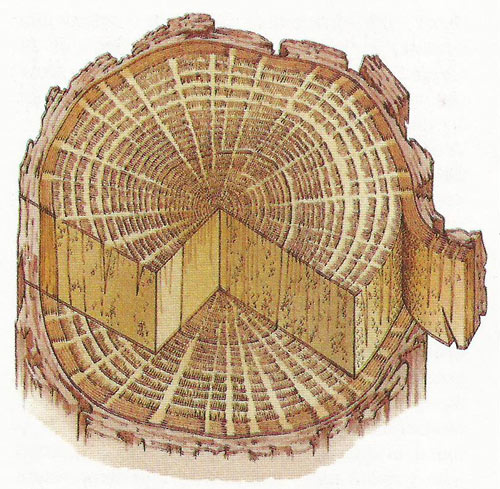xylem

Wood is made of the old xylem of previous years' growth, the walls of which have become heavily impregnated with lignin. The cells die and are embalmed in tannins and resins, forming the strong dark heartwood. This is surrounded by sapwood, which is weaker and makes up most of the thickness of the trunk in young trees. A layer of new sapwood is added to the outer edge of the column of wood with each year's growth, so forming a ring visible among others in the trunk. These are most apparent in temperature regions, where patterns of growth vary from season to season.
Xylem is tissue in the vascular (transport) system of plants that moves water and dissolved nutrients from the roots to the leaves and also provides mechanical support. The most important cells in xylem are long, thin tapering cells called xylem vessels. These cells are dead and have no cross-walls; they are arranged in columns to form long tubes, up which water is drawn.
As water evaporates from the leaves (see transpiration) water is drawn across the leaf by osmosis to replace it, drawing water out of the xylem. This process creates turgor pressure in the xylem vessels, which, along with rings of lignin that reinforce side walls and present them from collaPsing, provides support to the plant. Tiny holes in the walls of the xylem vessels, called pits, allow water to cross from one tube to another.
Ferns and conifers do not have xylem vessels. Instead they have similar cells called tracheids, which do not lose their end walls, so water has to travel through the pits, which slows the flow. The lignin makes the walls of vessels and tracheids strong and rigid, an important support as the plant grows bigger. Xylem tissue also contains non-conducting fibers, dead cells thickened with lignin for extra support.
Xylem is of two kinds: primary, formed by differentiation from procambium and consisting of protoxylem and metaxylem, and secondary, additional xylem produced by activity of cambium. In mature woody plants, xylem makes up the bulk of vascular tissue itself and of the entire structure of stems and roots.


